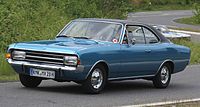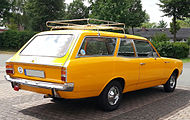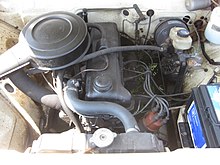Opel Rekord C
| Opel | |
|---|---|
|
Opel Rekord C Limousine 1900
|
|
| Record C | |
| Sales designation: | record |
| Production period: | 08 / 1966–01 / 1972 |
| Class : | upper middle class |
| Body versions : | Limousine , coupé , station wagon , panel van |
| Engines: |
Petrol engines : 1.5–2.2 liters (43–78 kW) |
| Length: | 4550-4574 mm |
| Width: | 1754 mm |
| Height: | 1456 mm |
| Wheelbase : | 2669 mm |
| Empty weight : | 1025-1240 kg |
| Previous model | Opel Record B |
| successor | Opel Rekord D |
The Opel Rekord C is an upper middle class vehicle from Adam Opel AG from the Opel Rekord range . From August 1966, the Rekord C replaced the “intermediate model” Rekord B, which had been built for just under a year, and came up with a completely new body. Production of the successor Rekord D began in December 1971.
Model history
General
The concept development of the Rekord C began in 1963 - Hans Mersheimer , who was chief engineer and technical director of Adam Opel AG until 1967, provided the guidelines. Because of the characteristic “hip swing” in the rear area, which some enthusiasts call “erotic”, which is comparable to the curves of a lying Coca-Cola bottle, the record C became known as the “ Coke-Bottle ” .
The body line followed a new style for muscle cars that emerged in the USA in the mid-1960s , the “ Coke Bottle Shape ” (according to which the Opel GT was also built). GM had specified the Chevrolet Chevelle as the orientation point for the design . At the same time, there were draft models of the Rekord C without this hip swing - due to the fear that such a body shape would not appeal to the German public. Attempts by Ford to follow this design were less successful in implementation (see Ford P7 ), so that this form was abandoned after a short time.
There were also some technical changes to the chassis: a longer wheelbase, an improved double wishbone at the front - independent suspension with coil springs and a stabilizer . The very simple, leaf-sprung rear axle of the predecessor gave way to a "five-link axle". This rigid axle with coil springs, four trailing arms and the Panhard rod , known by Opel as a wishbone, ensured significantly more stable handling. The concept of this rear axle guide was retained almost unchanged until production of the Opel Rekord E ended in mid-1986.
The dual-circuit brake system with brake booster worked on disc brakes at the front and drum brakes on the rear axle on all models . The passive safety was improved by a dashboard padded with foam, a telescopic steering column and effectively designed crumple zones. Three-point seat belts and headrests were available for the front seats at an additional cost . A glare-free round instrument replaced the typical Opel tape tachometer ("lead color tachometer"). The trade press carried out crash tests with the Rekord C and praised the stability of the passenger cell .
The Rekord C was the most successful Rekord model - Opel exceeded the million mark for the first time with it: 1,274,362 vehicles were built by January 1972. In September 1971, a Rekord C Caravan rolled off the production line in Rüsselsheim as the ten millionth Opel automobile since car production began in 1899.
The series was also manufactured and sold in other countries with different model names. The Ranger A was produced in South Africa , Belgium and Switzerland , the Chevrolet Opala (or Opala Comodoro and Opala Diplomata) in Brazil , Chile and Uruguay and the Opel Olympico in Mexico . The Chevrolet Opala rolled off the assembly line in Brazil until the early 1990s. Outwardly, it differed from the Rekord C by changing the front and rear.
overview
- August 1966 - Presentation of the Rekord C to the Opel dealers
- December 1966 - The new 2.2-liter in-line six-cylinder is available with all bodies.
- January 1967 - Introduction of the Rekord C Coupe
- October 1967 - The special model “Spar-Rekord” comes onto the market (simple equipment and only in gray paintwork).
- November 1967 - Start of production of the Rekord Sprint with 106 hp
- August 1968 - The six-cylinder engine is dropped from the record program due to lack of demand. As the successor to this variant, the Opel Commodore came onto the market in February 1967.
- November 1968 - Second series of the “Spar-Rekord”, now also in Sirius blue. The Powerglide two-speed automatic gave way to a new GM three-speed automatic.
- January 1969 - Since the Rekord Sprint is mainly sold as a coupé, the Sprint sedan is no longer available. The three-speed manual transmission is no longer available.
- January 1970 - The 1.5 liter engine is no longer part of the engine program.
- July 1971 - Special model Rekord “Holiday” with sliding roof, additional headlights and heated rear window.
- September 1971 - The record sprint is discontinued.
- January 1972 - End of production after 1,274,362 copies
variants
Body styles
The record was C as a two or four door saloon and five-door station wagon than three or caravan , as a three-door van (caravan without rear side windows) and from January 1967, as a coupe.
The coupé has no B-pillar and is considered by many fans to be the most elegant record model. In addition, from 1967 there was a convertible conversion based on the two-door record and the Commodore sedan from Karl Deutsch Karosseriebau in Cologne for a surcharge of DM 4,000.00 , but these are rare. Also Karmann in Osnabrück developed a convertible version, based on the Commodore, but did not go into production. It was based on the two-door sedan, with four side windows (instead of two in the German convertible), of which four were made that still exist today.
Opel Commodore with a six-cylinder engine
From February 1967 the Opel Commodore A was added to the range as a two- and four-door sedan and as a coupé. The Commodore filled the gap left by the Rekord B 6, but had the Admiral engine of the new generation introduced in August 1965, reduced to 2.5 liters.
The 2.2-liter straight-six remained in the engine range until August 1968. Compared to the only 5 hp weaker 1.9 S four-cylinder engine, it cost a considerable surcharge, which led to very low sales figures.
From autumn 1967 there was the record Sprint and the Commodore GS, analogous to the Rallye-Kadett. Due to changed emissions regulations, production of the Sprint was stopped in the late summer of 1971, a few months before the end of the rest of the model series.
Technology and innovation
Engines
The engine range partly corresponded to that of the predecessor; they were so-called CIH engines (with a camshaft in the cylinder head and the valves driven by rocker arms ).
The 1.5-liter engine initially had the carburetor of the Rekord A produced by Opel with a Carter license ; from 1969 onwards, like the new 1.7-liter normal gasoline engine, a Solex carburetor . The basic design of the 2.6-liter six-cylinder unit of the old Rekord B L-6 , which dates back to the Opel Super 6 from 1937, was no longer in the program, instead a newly developed 2.2-liter in-line six-cylinder was introduced in 1967 with the appearance of the Commodore A in the record was no longer offered. When record "Sprint" the performance of the engine by means of two 1.9 s was double - downdraft carburetor of the type 40 DFO of the Italian manufacturer Weber increased and altered HL (high-capacity) on the cylinder head 106 hp.
- 1.5N: 58 hp (from 1969: 60 hp; discontinued in 1970)
- 1,7N: 60 HP (from 1969: 66 HP)
- 1.7S: 75 hp
- 1.9S: 90 hp
- 1,9H: 106 PS (only in the special model Rekord "Sprint")
- 2.2N: 95 PS (six-cylinder, only until 1967)
transmission
- Three-speed (up to 1970) or four-speed manual transmission with steering wheel gearshift (for an extra charge with center gearshift, standard on the Coupé)
- On request a two-speed Powerglide automatic transmission from General Motors , optionally the Olymat semi-automatic (automatic clutch) from Fichtel & Sachs for three-speed transmission (until 1970)
At the end of 1968, a three-speed TH180 automatic from the GM plant in Strasbourg replaced the technically overhauled Powerglide transmission.
Technical specifications
| Technical data Opel Rekord C 1966–1972 | |||||||
|---|---|---|---|---|---|---|---|
| Opel record: | 1500 | 1700 | 1700 p | 1900 p | 1900 H. | 2200 | |
| Engine: | Four-cylinder - inline engine ( four-stroke - gasoline engine ) | Six-cylinder in-line engine | |||||
| Displacement: | 1492 cc | 1698 cc | 1897 cc | 2239 cc | |||
| Bore × stroke: | 82.5 x 69.8 mm | 88 x 69.8 mm | 93 x 69.8 mm | 82.5 x 69.8 mm | |||
| Performance at 1 / min: |
43–44 kW (58–60 hp) at 5200 |
44–48 kW (60–66 hp) in the 4600 |
55 kW (75 PS) at 5200 |
66 kW (90 PS) at 5100 |
78 kW (106 hp) at 5600 |
70 kW (95 hp) at 4800 |
|
| Max. Torque at 1 / min: |
103 Nm at 2500 |
116-118 Nm at 2300-2550 |
127 Nm at 2700 |
146 Nm at 2800 |
157 Nm at 3650 |
157 Nm at 3200 |
|
| Compression: | 8.2: 1 | 8.2: 1 | 8.8: 1 | 9.0: 1 | 9.5: 1 | 8.2: 1 | |
| Mixture preparation: | An Opel downdraft carburetor (license Carter Carburetor ) |
A Solex 35 PDSI downdraft carburetor |
One register - downdraft carburetor Solex 32 DIDTA |
Two double downdraft carburetors Weber 40 DFO | A register downdraft carburetor | ||
| Valve control: | ( CIH ) Overhead valves (overhead camshaft driven by duplex roller chain) | ||||||
| Cooling: | Water cooling | ||||||
| Transmission: | Three or four-speed manual gearbox with steering wheel or center shift (“stick shift”), for an extra charge for 1900 S / H and 2200: two-speed automatic transmission General Motors - “Powerglide”, from 1968 three-speed automatic type GM TH180 |
||||||
| Front suspension: | Independent suspension on double wishbones , coil springs | ||||||
| Rear suspension: | Opel “five- link axle”: Rigid axle with four trailing arms and Panhard rod ( wishbone ), coil springs | ||||||
| Body: | Self-supporting body made of sheet steel | ||||||
| Track width front / rear: | 1412/1410 mm | ||||||
| Wheelbase: | 2668 mm | ||||||
| Length: | 4550 mm (L and Coupé: 4574 mm) | ||||||
| Empty weight: | 1025-1240 kg | ||||||
| Top speed: | 130-136 km / h | 135-141 km / h | 145–153 km / h | 152-161 km / h | 175 km / h | 155-163 km / h | |
| 0-100 km / h: | 24-28 p | 20-24 s | 18-22 p | 16-20 s | 12.0 s | 15-19 p | |
| Consumption (liters / 100 kilometers): | 11.0 N | 12.1 N | 11.5 S. | 12.0 S. | 14.0 p | 13.0 S. | |
The 1700 record had the largest market share. In 1967 it cost around 7,800 DM. The gasoline consumption on the autobahn at an average of 110 km / h was 11.2 l / 100 km, in the city, depending on traffic density, 13-14 l / 100 km, on a flat country road 11.5 l / 100 km. On average, this resulted in a consumption of 12.1 liters of regular gasoline per 100 km. Thus the 55-liter tank was sufficient for a distance of approx. 455 km. The over 1000 kilogram heavy car with a 60 hp engine accelerated from zero to 100 km / h in 20.2 seconds. The 1700S version with 75 hp was around 5 seconds faster and cost 95 DM more. A top speed of 134 km / h is specified for the 1700 and 148 km / h for the 1700S. With an emergency stop from 100 km / h, the 1700 came to a stop after 50.2 meters. It had disc brakes at the front and drum brakes at the rear. The turning circle was 11.9 meters.
Black widow
After the start of series production, Anatole Lapine developed a racing version of the Opel Rekord C. Because of its black paintwork, this vehicle, which had an output of 180 hp, was also known as the black widow or taxi . Between 1967 and 1969 it was driven by Erich Bitter and Niki Lauda , among others , without achieving any major success despite its spectacular driving characteristics. In the early 1970s, the black widow disappeared without a motor near Vienna; the whereabouts of the vehicle is unclear.
In 2012, the Black Widow was recreated by Opel Classic , with the help of Lapine being used due to a lack of plans.
literature
- Alexander Franc Storz: Typenkompass Opel: Passenger cars since 1945. 1st edition, Motorbuch Verlag, Stuttgart, 2008. ISBN 978-3-613-02930-9 .
Web links
Individual evidence
- ↑ a b Eckhart Bartels, Rainer Manthey: Opel: Vehicle Chronicle Volume 2: 1952–1990. Podszun, Brilon 2012, ISBN 978-3-86133-620-4 , pp. 8/9 and 38/39.
- ↑ Information on the Coke Bottle Design of the Opel Rekord C.
- ↑ Model draft of the Opel Rekord C by Herbert Killmer without "hip swing"
- ↑ Rainer Günzler tests the Opel Rekord C 1967 - Part 1 and Part 2. In: YouTube . June 29th 2009, accessed on August 3, 2015 (from the ZDF telecast Sport mirror , again aired on 3sat ).
- ↑ a b Opel blog: Black widow - like a phoenix from the ashes , entry from July 9, 2012.











